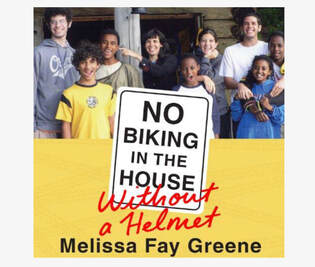As they neared each child leaving the nest, they began having an itch to refill the nest again, rather than getting closer to an empty one. At first, they became aware of the plight of the children in Eastern European orphanages, where children were languishing with minimal food and almost no adult attention. This led the to their first adoption of four-year-old Jesse. She describes so well the wave of being pushed along by the tide of paperwork and family expectation, once you start the process of adoption, until you find yourself in another country and suddenly the only adult responsible for another human being who is a stranger to you. The feelings of “What have I done!” and the uncertainty that continues as you wait to see, over years, what the potential of this child will be in a loving environment. She describes a little of the struggle of post-adoption depression, bringing light to this little-known phenomenon that is so hard to talk about when the new parents are supposed to be happy and content with their new family.
As Jesse grows and the next child goes off to college, they become aware of the phenomenon of orphans in Africa flooding humanitarian organizations and becoming available for adoption due to the loss of their parents to HIV/AIDs. They are matched with a precious 5-year-old girl who had been the only child of parents who had died of AIDs. Melissa travels to Ethiopia, and this opens up a new panorama of people and places to the reader. Melissa develops a relationship with a woman who, after losing her own children, became a default mother for hundreds of AIDs orphans. Through these relationships the Green family ends up adopting another three older boys over the years. The stories of bringing home boys who had been shepherds in Africa, watching their families’ animals alone by the age of 5 are amazing. These children have talents and strengths rarely seen in Georgia, and yet the adjustment of adding an older child to a family that already has its own groove has its challenges, including an 18-day stretch of the “silent treatment.” As the children become settled in their new life and identities as American teenagers, the family eventually makes a connection with the biological family members of each child. I love that they are able to keep a connection with their roots and ancestry. They provide support to family members in the third world conditions of Ethiopia. At one point, when Sol from Ethiopia is notified that his birth mother has been found and is coming to see him again, Jesse from Bulgaria cries harder than Sol out of joy for his brother! This is a fun memoir-style book that will have you laughing many times. (I listened to it on audio and my kids kept asking what I was laughing at.) But it also gives some insight into the real hardness of adoption, including post-adoption depression, the difficulty of dealing with the unknowns and unanswered questions, the exhaustion, and the struggle to attach, make children feel safe, set boundaries, and mesh into a family unit. It is a celebration of accepting different cultures and people of different religious backgrounds, as well as a reminder that all children who have become available for adoption will have some amount of trauma. The more we can be prepared, lower our expectations for ourselves and them, have lots of grace, and get connected with the best support in our area, the more likely we are to have a joyful journey to becoming a family. More resources for adoptive and foster families can be found at www.traumainformedmd.com. Laura Shamblin, MD
1 Comment
In the last month I have had an article published by two major blog sites for physicians. I was inspired to pass on what I've been learning about secondary post-traumatic stress, which is the physical reaction that our bodies have when we hear stories of the trauma of other people, like our patients. This happens to physicians, nurses, first-responders, pastors, counselors and others. As physicians, we are reluctant to show any weakness or admit any mental health struggles due to our own expectations and the pressures of the healthcare system. Please read my take on this struggle and the steps anyone can take to reduce the burden of their own stress.
See OpMed article HERE See KevinMD article HERE |
Laura Shamblin, MDEditor-in-chief of TraumaInformedMD.com Archives
April 2022
Categories |



 RSS Feed
RSS Feed